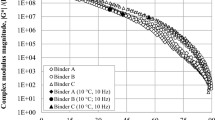Abstract
In France, tensile tests on bituminous binders are usually performed on vertical electromechanical loading frames, the test samples being placed in an insulated temperature control chamber and the deformations determined from the displacement of the cross-head. The paper presents the results of an inter-laboratory study of which the objective was to evaluate the suitability of this kind of equipment for the performance of direct tension tests at low temperatures. Most of the test parameters, used for this study complied with the procedure proposed by SHRP as from 1995 (AASHTO TP3). The various operating factors, and more particularly those affecting the determination of true sample elongation (mechanical plays, deformation of the gripping systems, ....), are discussed and a number of correcting procedures are proposed. Nevertheless, the results remained scattered. Considering the “flat” evolution of strain at failure with temperature in the domain of brittle behaviour, this makes it rather difficult to accurately define the temperature for failure at 1% elongation (Tε=1%). This is also the case when this temperature is located in the zone of transition between brittle and ductile behaviour. The authors suggest that, together with the corresponding tensile strain, this “transition temperature” could be used as an alternative criterion which has the advantage of being linked to a physical behaviour of the material.
Résumé
En France, les essais de traction sur des éprouvettes de liants bitumineux sont classiquement réalisés avec des machines de traction verticales de type électro-mécaniques, l'éprouvette étant placée dans une enceinte climatique et les déformations mesurées d'après le déplacement de la traverse. La communication présente les résultats d'une étude interlaboratoire dont l'objectif était d'évaluer l'aptitude de tels dispositifs à la réalisation d'essais de traction á bases températures. La plupart des paramètres opératoires retenus pour cette étude étaient conformes à la procédure SHRP postérieure à 1995 (AASHTO TP3). Les différents facteurs affectant notamment la détermination précise de l'allongement réel de l'éprouvette (rattrapages de jeux, déformations des systèmes d'attache, ...) sont discutés et des procédures de correction proposées. Malgré cela, la dispersion des résultats reste importante ce qui, dans un domaine de comportement fragile où la courbe allongement à la rupture/température est très plate, rend la détermination précise de la température de rupture à 1% d'allongement (Tε=1%) assez délicate. Il en va de même lorsque cette température se situe dans la zone de transition entre un comportement fragile et, un comportement ductile. Les auteurs suggèrent que cette «température de transition», associée à la déformation de traction correspondante, pourrait constituer un critère alternatif ayant l'avantage d'être lié à un comportement physique du matériau.
Similar content being viewed by others
References
‘Projet de mode opératoire. Liants bitumineaux— Détermination des propriétés à la rupture à basse température par essai de traction directe’, LCPC, mars 1995.
Bahia, H., Zeng, M. and Nam, K., ‘Consideration of strain at failure and strength in prediction of pavement thermal cracking’, Proc. of AAPT Conference, Reno, Nevada, Vol. 69 (March 2000) 497–539.
Sauger-Vauthier, E., Hammoum, F., Ollier, S. and Such, C., ‘Towards a better understanding of the SHRP tensile test’, Eurobitume Workshop 99, paper No 055, Luxemburg (April 1999).
Dongré, R. and d'Angelo, J., ‘Effect of new direct tension test protocal on the SUPERPAVE low-temperature specification for bitumen binders’, Proc. of BCRA'98 Conference, Trondheim, Norway, July 6–8, 1998.
Author information
Authors and Affiliations
Additional information
Editorial Note Presented at the 6th International RILEM Symposium on Performance Testing and Evaluation of Bituminous Materials (PTEBM/03), held on 14th–16th April 2003, in Zurich, Switzerland, this paper was selected as an outstanding communication and peer-reviewed by the Scientific Committee of the JournalMaterials and Structures. Mrs. Emmanuelle Sauger participates in RILEM TC 182-PEB ‘Performance testing and evaluation of bituminous materials’.
Rights and permissions
About this article
Cite this article
Largeaud, S., Raffegeau, H., Simaillaud, B. et al. The use of direct tension tests for the assessment of low temperature properties of bituminous binders. Mat. Struct. 37, 351–355 (2004). https://doi.org/10.1007/BF02481682
Received:
Accepted:
Issue Date:
DOI: https://doi.org/10.1007/BF02481682




